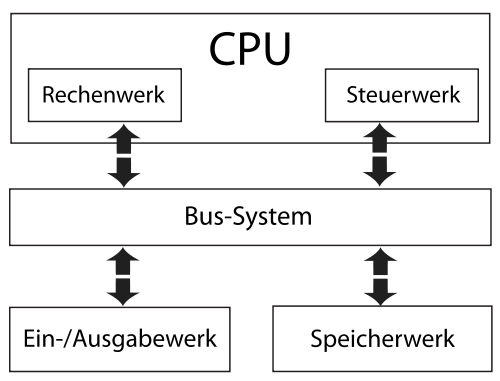Organisatorisches
Fragen vorab
- NASM und benötigte Werkzeuge erfolgreich installiert?
- Konfiguration getestet?
- Wie sieht es mit dem 1. Übungszettel aus?
Vorlesung
von-Neumann-Architektur
- Programme = Daten

Simpler Interpreter
1 2 3 4 5 6 7 8 9 10 11 12 13 14 15 16 17 18 19 20 21 22 | |
(Beispiel aus der Vorlesungsfolie.)
Assembler
Register vs. Hauptspeicher
- Hauptspeicher ist zu langsam für die CPU
- CPU hat zusätzlichen schnellen Speicher direkt an der CPU: Register
rax, rbx, rcx, rdx, rsi, rdi, rbp, rsp, r8, r9, r10, r11, r12, r13, r14, r15- (Nur) auf den Registern können Operationen ausgeführt werden
- Die ersten 8 Register haben spezielle Bedeutung
- Vor allem bei Funktionsaufrufen (Calling Conventions)
Register
Wir haben 16 Register
schnelles Rechnen
Übergabe von Parametern
Rückgabe von Funktionswerten
Register im Detail
Siehe hierzu die AMD-Doku, Seite 39, PDF-Seite 75.
Assembler-Operationen
Aufbau:
operation operand_1, operand_2Manchmal nur ein Operand, manchmal auch keiner, sehr selten auch drei
operand_xkann je nachoperationverschiedenes sein:- Register (
rax,rbx, …) - Konstanter Wert (
234,45, …) - Sprungmarke (im Data-Bereich)
- Speicherstelle (
[rax+8]; kommen wir in einem späteren Tutorium noch zu)
- Register (
Kopiere Wert
Syntax
mov zieloperand, quelloperand
Semantik
zieloperand = quelloperand
Beispiel
1 2 | |
Inkrement
Syntax
inc zieloperand
Semantik
zieloperand = zieloperand + 1
Beispiel
1 2 3 | |
Dekrement
Syntax
dec zieloperand
Semantik
zieloperand = zieloperand - 1
Beispiel
1 2 3 | |
Addition
Syntax
add zieloperand, quelloperand
Semantik
zieloperand = zieloperand + quelloperand
Beispiel
1 2 3 | |
Subtraktion
Syntax
sub zieloperand, quelloperand
Semantik
zieloperand = zieloperand - quelloperand
Beispiel
1 2 3 | |
Programmsteuerung
Bisher
Langweilige Programme
- Keinerlei Bedingungen, Schleifen, etc.
Schön wäre so etwas wie
if <Bedingung> then <Code> else <Code>oder
while <Bedingung> <Code> endGeht leider nicht so einfach
Sprung
Wir können innerhalb unseres Programms springen:
1 2 3 4 5 6 7 8 9 10
func: jmp marke2 marke1: mov rax, rbx jmp marke3 marke2: mov rbx, 20 jmp marke1 marke3: retjmp markebedeutet: Setze das Programm in der Zeile mitmarke:fort.Leider wird immer gesprungen.
Vergleichen
Wir wollen nur bei bestimmten Bedingungen springen.
Bedingung bedeutet meistens: Wir wollen zwei Werte miteinander vergleichen.
Syntax
cmp operand_1, operand_2
Semantik
Rechne operand_1 - operand_2 und setze Statusregister.
Statusregister
- Zusätzlich zu den Registern, mit denen wir rechnen hat die CPU noch sogenannte Statusregister.
- Speichern zusätzliche Informationen zum Ergebnis
- z.B.:
ZFwird auf 1 gesetzt, wenn das Ergebnis einer Operation 0 ist
- z.B.:
Bedingter Sprung
Es gibt Sprungbefehle, die nur springen, wenn bestimmte Bedingungen wahr sind ⇒ bedingte Sprünge
Sie arbeiten auf Basis der Statusregister
Meist in Kombination mit einem davor ausgeführten
CMP-Befehl
Beispiele
Bedingter Sprung (weiter)
Produkt berechnen
1 2 3 4 5 6 7 8 9 10 11 12 13 14 | |